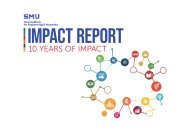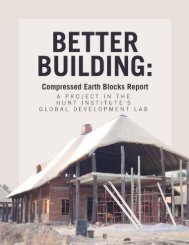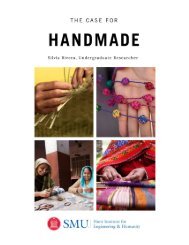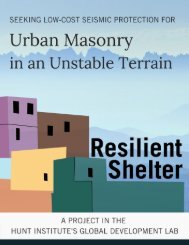Building Fences to Build Connections
Kasisa Village is a rural village in the East African country of Tanzania. This project is designed to improve the quality of life of its residents. Clara Ford, founder of Kijiji Innovative Sustainable Solutions (KISS), has directed her efforts toward building a community center with goals of reducing cyclical poverty and empowering the local people with technical skills. The locals of Kasisa Village are stakeholders in the planned center, which will function as a testing ground for social impact implementation in their community. This partnership for community development is a core value for Ford, the KISS Board of Directors, and the Hunt Institute.
Kasisa Village is a rural village in the East African country of Tanzania. This project is designed to improve the quality of life of its residents. Clara Ford, founder of Kijiji Innovative Sustainable Solutions (KISS), has directed her efforts toward building a community center with goals of reducing cyclical poverty and empowering the local people with technical skills. The locals of Kasisa Village are stakeholders in the planned center, which will function as a testing ground for social impact implementation in their community. This partnership for community development is a core value for Ford, the KISS Board of Directors, and the Hunt Institute.
Create successful ePaper yourself
Turn your PDF publications into a flip-book with our unique Google optimized e-Paper software.
Building Fences to Build Connections
Concluding Observations
The goal of the best practices research was to determine which methods of fencing
will be successful in terms of environmental, economic, and cultural sustainability. I
determined three methods of unique and sustainable fencing such as a living wall fence,
a beehive fence, and a chili-oil fence, while also considering the standard option of a
chain link fence. Considering these options, I moved forth with two recommendations
enumerated in option 1 and option 2 above. Option 1 entails a living wall fence along the
front and back of the center, while chain link covers the perimeter on the side. Option 2
is the inverse and involves a living wall fence along the side, while using a chain link fence
for the front and back, both options give weight to sustainability and cost effectiveness.
At this point in the analysis, it would be crucial to move forward and collect exact
pricing for the cost of the chain link fence and African myrrh tree limbs to get a better
picture of costs as the project moves towards implementation.
Izzah Zaheer, Hunt Institute Undergraduate Research Analyst Page 18













